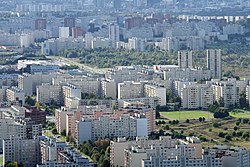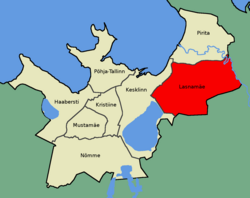Lasnamäe
| Lasnamäe | |||
|---|---|---|---|
| District of Tallinn | |||

Lasnamäe seen from the air.
|
|||
|
|||
 Location of Lasnamäe in Tallinn. |
|||
| Coordinates: 59°26′15″N 24°49′39″E / 59.43750°N 24.82750°ECoordinates: 59°26′15″N 24°49′39″E / 59.43750°N 24.82750°E | |||
| Country | Estonia | ||
| County | Harju County | ||
| City | Tallinn | ||
| Government | |||
| • District Elder | Maria Jufereva (Centre Party) | ||
| Area | |||
| • Total | 30.0 km2 (11.6 sq mi) | ||
| Population (01.11.2014) | |||
| • Total | 118,557 | ||
| • Density | 4,000/km2 (10,000/sq mi) | ||
| Website | lasnamae-district | ||
Lasnamäe is the most populous administrative district of Tallinn, the capital of Estonia. The district's population is about 119,000, the majority of which is Russian-speaking. Local housing is mostly represented by 5–16 stories high panel blocks of flats, built in the 1970–1990s. Lasnamäe is usually referred to as a bedroom community.
The district lies in the eastern part of Tallinn. In the east it is bordered by the Pirita River; in the north and northwest a limestone escarpment (part of the Baltic Klint) separates Lasnamäe from Pirita and Kesklinn. The district is situated on a flat limestone plateau that lies 30–52 m above sea level. The highest point in Lasnamäe is the Sõjamägi Hill at 54 m asl.
Lasnamäe can be divided into two distinct areas: the northern part is residential, while the southern part around Peterburi Road (Tallinn-Narva road, part of E20) and up to the border with Rae Parish is mainly industrial. Lennart Meri Tallinn Airport is also administratively located in Lasnamäe.
The oldest traces of human activity in the Lasnamäe area date from Early Neolithic.
In the Middle Ages some small hamlets were situated on the territory of present-day Lasnamäe. At that time Lasnamäe was mainly known for limestone quarries, as nearly the whole of Medieval Tallinn was built of local limestone.
At the end of the 19th century, during the period of industrial expansion, some major factories were set up in Lasnamäe, including the Dvigatel factory, which had 2,260 workers in 1900. In 1904 Sikupilli, the first residential suburb in Lasnamäe, was laid out. Sikupilli remained the main residential area of Lasnamäe until the construction of microdistricts started in the 1970s.
...
Wikipedia


